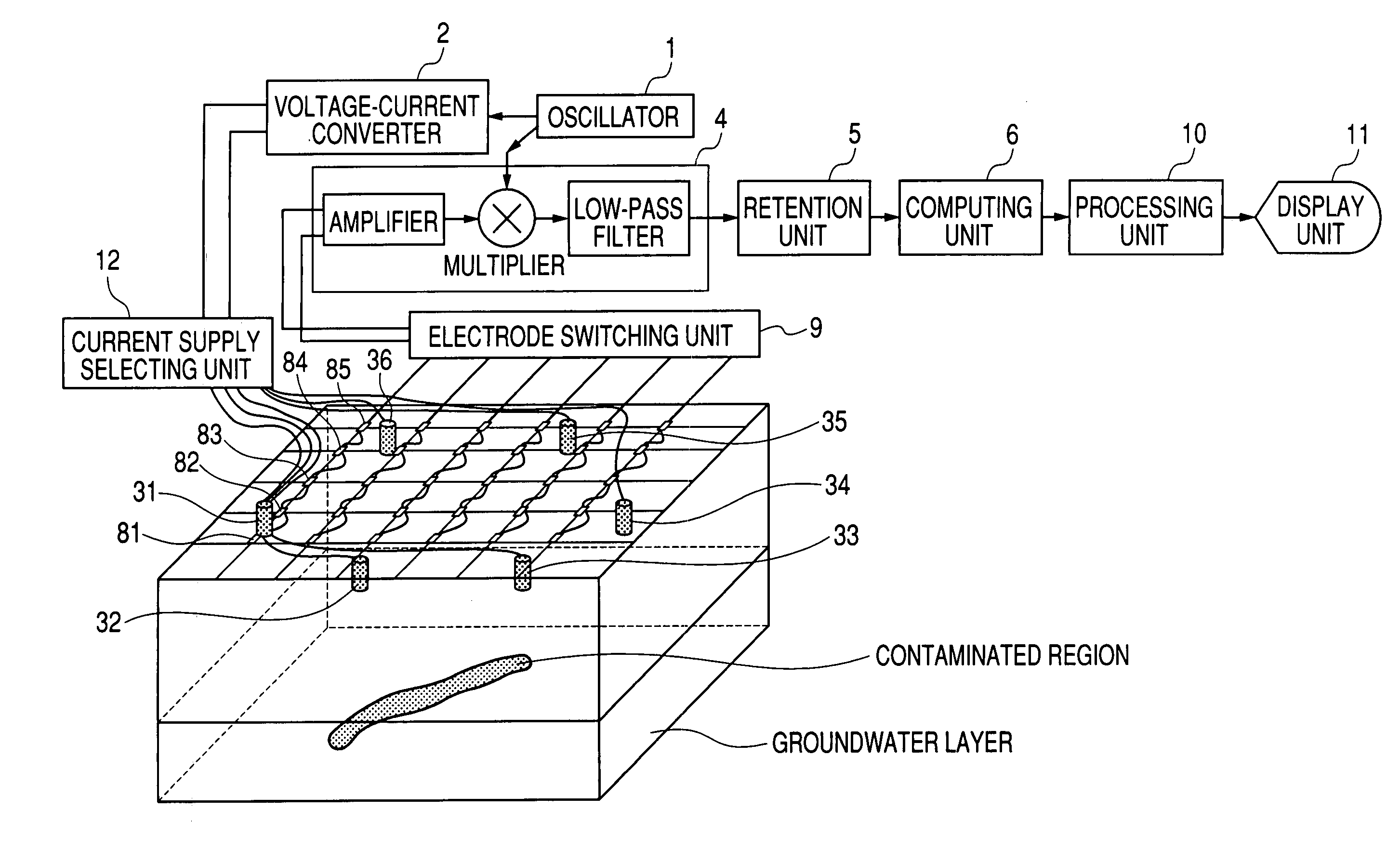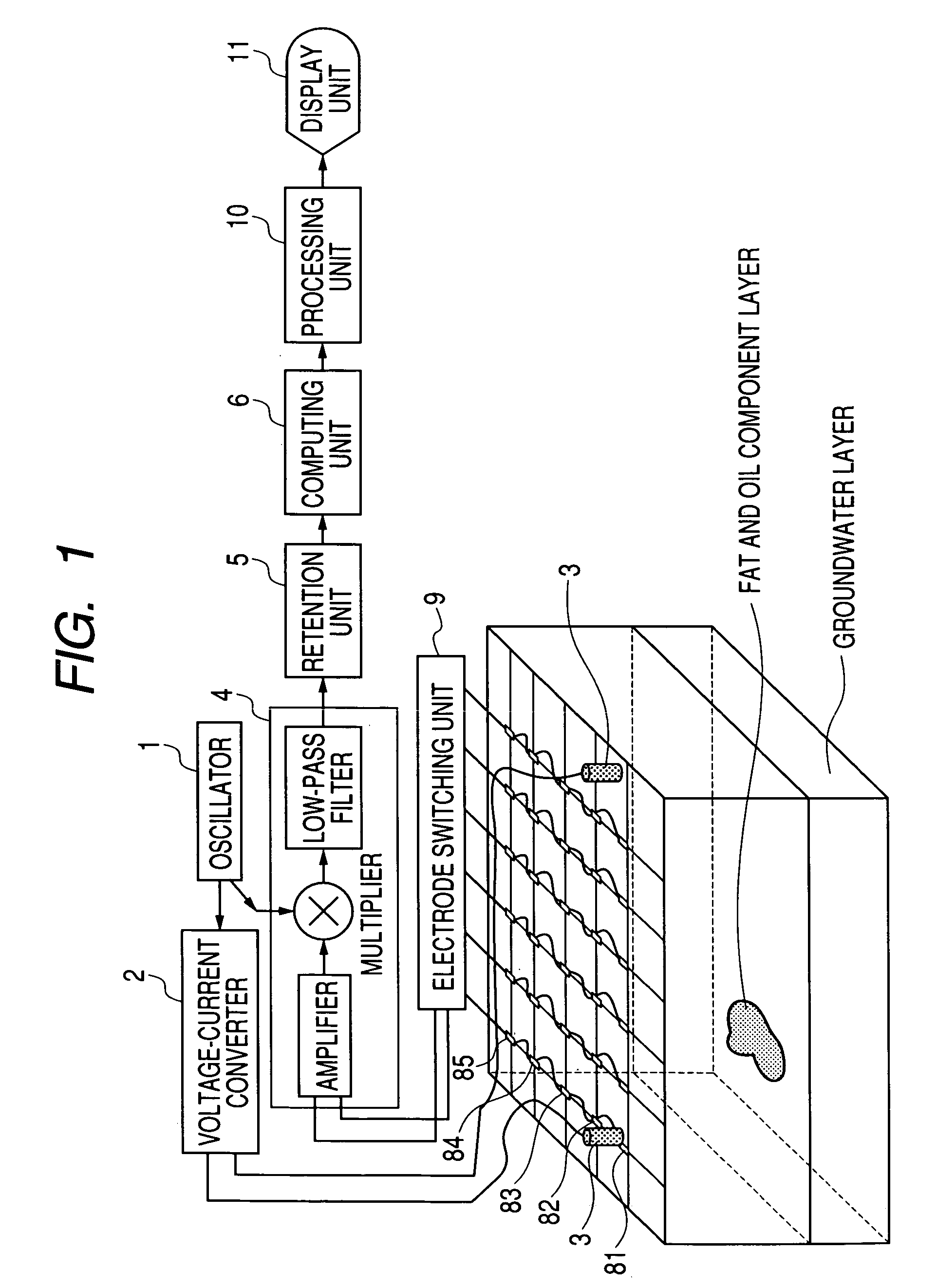Underground exploration apparatus, system and method
a technology of underground exploration and equipment, applied in the field of measurement equipment, can solve the problems of inability the inability of the acoustic exploration method to detect the depth of an underground stream and the presence of underground resources, and the inability of the acoustic exploration method to find the substance of the geological layer
- Summary
- Abstract
- Description
- Claims
- Application Information
AI Technical Summary
Benefits of technology
Problems solved by technology
Method used
Image
Examples
embodiment 1
[0092]FIG. 2 is a table showing the fact that substances constituting the ground, chemicals, and the like have different specific dielectric constants, which forms the basis of the measurement principle of the present invention. Specific dielectric constant is a coefficient indicating the readiness of the corresponding substance to polarize, in relation to the vacuum dielectric constant. The substance's actual dielectric constant ε can be obtained by multiplying the vacuum dielectric constant by the specific dielectric constant of the substance. The dielectric constant generally fluctuates depending on the frequency and temperature employed in the measurement.
[0093]FIG. 3 is a diagram illustrating the frequency dependency of the dielectric constant and fluctuation factors thereof. as mentioned, the dielectric constant is a coefficient indicating the readiness to polarize. There are four known types of polarization of a substance: interface polarization, dipole polarization, ion pola...
embodiment 2
[0101]FIG. 9 is a diagram illustrating a detailed structure of an oscillator 1 according to another embodiment of the present invention. There are various electric currents flowing under the ground that can be disturbances to AC tests. Such electric currents include those accompanying movement of static electricity build-up in the ground, or flowing back from a power transmission line or the overhead wire of a railway through the ground, or leaking from an electric appliance, and the like. In order to detect a minuscule change in impedance without being influenced by those currents, it is preferable to use an oscillator structured as shown in FIG. 9.
[0102]A sine-wave generator shown in FIG. 9 generates a sine wave to supply the signal to a multiplier and, in addition, supplies a clock signal to an M-sequence generator in sync with a fundamental frequency. The M-sequence generator is an electronic circuit for generating a maximum length code sequence (“M-sequence code”), which is a b...
embodiment 3
[0105]FIG. 1 is a diagram showing the structure of an underground exploration apparatus according to a still another embodiment of the present invention. In FIG. 1, a transmitter waveform generated by the oscillator 1 is converted into current by the voltage-current converter 2 and then conducted to the ground via the ends of the pair of current application electrodes 3. As a result of the current conduction, a high frequency voltage generated between two arbitrary electrodes chosen out of the N voltage measurement electrodes 81, 82, 83, 84, . . . , 8N, which are provided to measure a high frequency voltage induced on the ground surface, is supplied to an amplifier via the electrode switching unit 9. The high frequency voltage is multiplied in sync with the transmitted wave, and is passed through a low-pass filter for synchronous detection processing. The measuring unit 4 composed of the amplifier, the multiplier, and the low-pass filter serves as a synchronous detection circuit. An...
PUM
| Property | Measurement | Unit |
|---|---|---|
| specific dielectric constant | aaaaa | aaaaa |
| specific dielectric constant | aaaaa | aaaaa |
| frequency | aaaaa | aaaaa |
Abstract
Description
Claims
Application Information
 Login to View More
Login to View More - R&D
- Intellectual Property
- Life Sciences
- Materials
- Tech Scout
- Unparalleled Data Quality
- Higher Quality Content
- 60% Fewer Hallucinations
Browse by: Latest US Patents, China's latest patents, Technical Efficacy Thesaurus, Application Domain, Technology Topic, Popular Technical Reports.
© 2025 PatSnap. All rights reserved.Legal|Privacy policy|Modern Slavery Act Transparency Statement|Sitemap|About US| Contact US: help@patsnap.com



